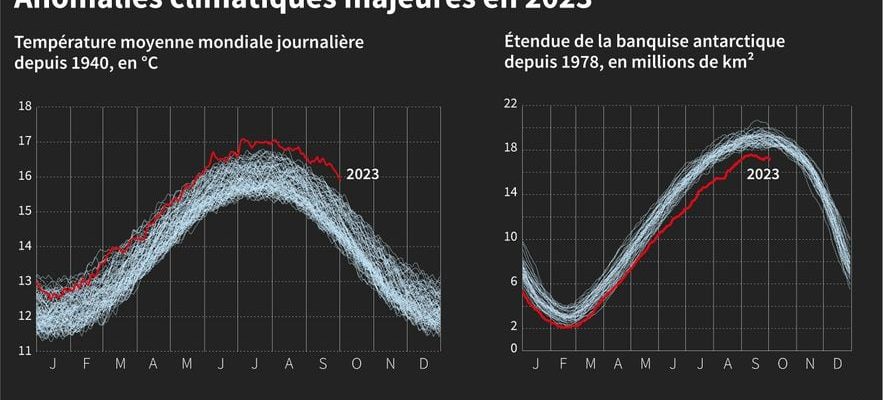It was expected, it is now confirmed: 2023, marked by a procession of unprecedented climatic disasters, is indeed the hottest year in history, flirting for the first time in an entire year with the limit of 1, 5°C of global warming set by the Paris agreement.
With an average temperature of 14.98°C, the past year was 1.48°C warmer than the climate of the pre-industrial era (1850-1900), announced this Tuesday, January 9 the European Copernicus observatory in its annual report. The new record exceeds by a large margin (0.17°C) the previous one, although recent, from 2016.
Behind this thermometer measurement lies a long list of climate catastrophes, fueled by humanity’s greenhouse gas emissions: massive fires in Canada, extreme droughts in the Horn of Africa or the Middle East, unprecedented summer heatwaves in Europe, the United States and China, record winter heat in Australia or South America, devastating precipitation, stronger hurricanes, etc.
If annual data from Copernicus goes back to 1850, the temperatures recorded in 2023 “probably exceed those of all periods for at least 100,000 years”, known thanks to tree rings or ice cores, commented Samantha Burgess, deputy head of the Copernicus Climate Change Service (C3S). “2023 was an exceptional year, with climate records falling like dominoes,” she added.
Peak emissions?
The annual report is published one month after the United Nations Climate Conference in Dubai. COP 28, responsible for establishing a corrective to save the 1.5°C objective of the Paris agreement, produced a historic agreement paving the way for the gradual abandonment of fossil fuels, the main causes of global warming. climate, despite numerous concessions to countries rich in oil and gas.
“It is probable” that the bar of 1.5°C of warming over 12 rolling months will be measured “in January or February 2024”, despite the cold which is crossing Europe at the moment, predicts Copernicus. This anomaly must however be noted on average over “at least 20 years” to consider that the global climate has reached this limit, recalls the observatory. But this perspective is getting closer: to meet this limit, the reduction in greenhouse gas emissions must reach -43% by 2030 compared to 2019, according to climate experts from the IPCC. However, the global decline has not yet started, even if some experts announce that the peak of emissions is imminent. The current climate is considered to have already warmed stably by around 1.2°C compared to 1850-1900. And at the current rate of emissions, the IPCC predicts that the threshold of 1.5°C has a one in two chance of being reached on average by the years 2030-2035.
Overheating oceans
In 2023, “for the first time, every day of the year was 1 degree warmer” at least compared to the pre-industrial era. Two days in November even exceeded 2 degrees of warming.
The year, marked by the start of El Niño, a phenomenon synonymous with additional warming which should reach its full extent in 2024, saw eight months in a row of monthly records, from June to December. July 2023 now holds the all-time monthly record, immediately followed by August 2023.
Of the nearly 30,700 days since 1940, the 46 hottest days were measured in 2023, all last summer, in July and August, according to Copernicus data analyzed by AFP. In Europe, 2023 ranks as the second warmest year, behind 2020.
The world’s oceans have also been overheating in a “persistent and unusual manner”, with seasonal records constantly broken since April. These temperatures, unprecedented for nine months, threaten marine life, increase the intensity of storms and warm the atmosphere. They are particularly scrutinized by climatologists, given the major role of climate regulator played by the oceans, which absorb more than 90% of the excess heat caused by human activity.
Major climate anomalies in 2023
© / afp.com/Paz PIZARRO, Sylvie HUSSON, Clement KASSER
This increase also has the effect of accelerating the melting of the floating ice shelves of Greenland and Antarctica, crucial for retaining fresh water from glaciers and preventing massive rise in ocean levels. Antarctic sea ice reached record low levels for eight months of the past year. With “the extremes observed in recent months […] we are now far from the climate in which our civilization was able to develop,” warns Carlo Buontempo, director of C3S.
